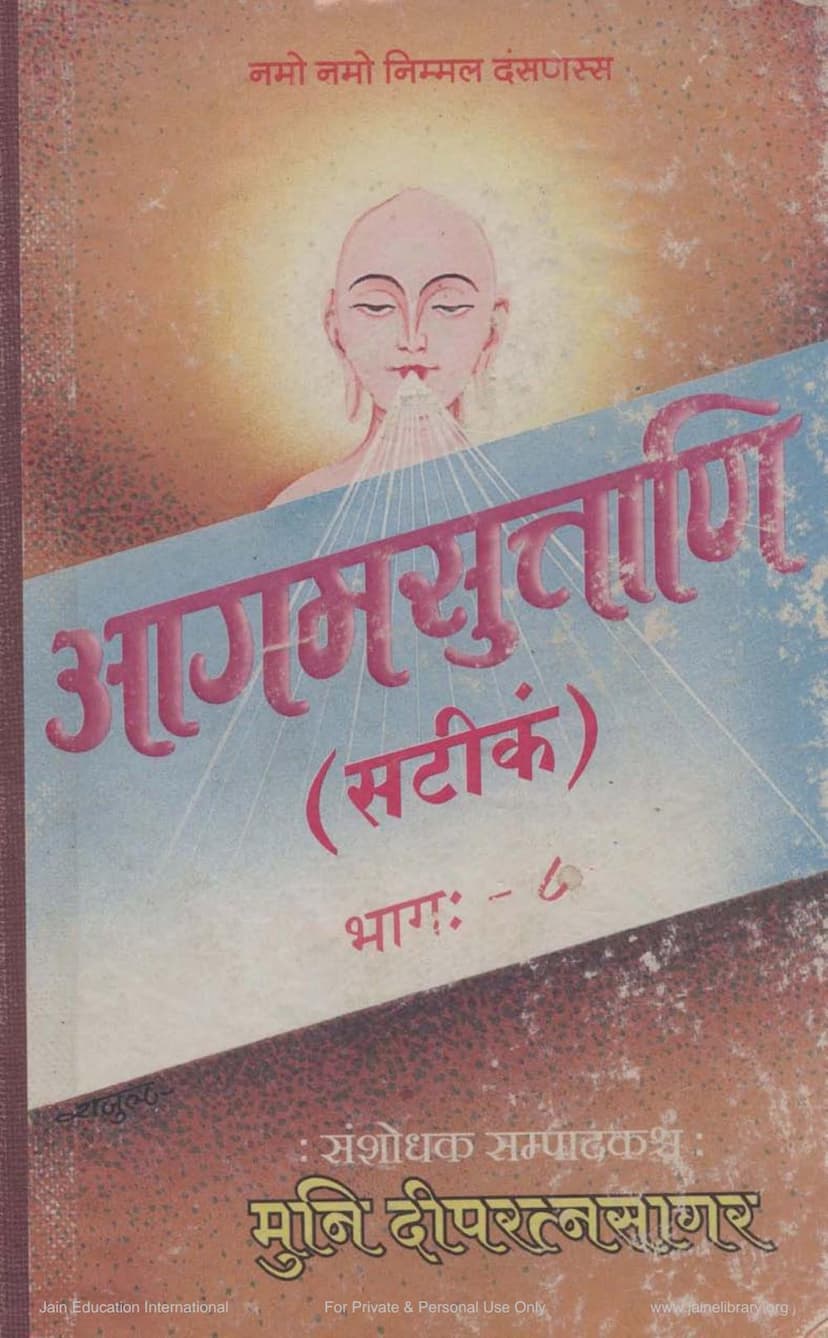Agam Sutra Satik 12 Auppatik UpangSutra 01
Added to library: September 1, 2025

Summary
Here's a comprehensive summary of the Jain text "Agam Sutra Satik 12 Auppatik UpangSutra 01" based on the provided pages:
Book Title: Agam Sutra Satik 12 Auppatik UpangSutra 01 Author(s): Dipratnasagar, Deepratnasagar Publisher: Agam Shrut Prakashan Catalog Link: https://jainqq.org/explore/003346/1
This volume, part of a larger series "Agam Sutrani (Satik)" (Agam Sutras with Commentary), is specifically Volume 8. It focuses on three key Jain texts with detailed commentary, compiled and edited by Muni Dippratnasagar.
Core Texts Included:
- Vipaka Shrutanga Sutra: The table of contents (Page 3) indicates this scripture is divided into two major sections: Shrutaskandha-1 and Shrutaskandha-2. Shrutaskandha-1 contains ten chapters (Adhyayans) covering stories of individuals like Mrigaputra, Ujjhitaka, Abhayagresen, Shakat, Brihaspatidatta, Nandivardhana, Umbardatta, Sauryadatta, Anju, and Jinadasa, detailing their actions and consequences. Shrutaskandha-2 also contains ten chapters, likely continuing the theme of karmic retribution with narratives involving Subahu, Bhadranandi, Sujata, Muvasava, Dhanavati, Mahabala, Mahachandra, and Varadatta.
- Aupapātik Upanga Sutra: This text, presented from Page 8 onwards, is described as the first Upanga Sutra. The commentary begins with an explanation of the term "Aupapātik" referring to the spontaneous birth or descent of beings, particularly devas and Narakis, or the attainment of Siddhahood. It details the city of Champanagari, the Purnabhadra Chaitya, the Ashoka tree, and aspects of Mahavira's monastic life, including descriptions of elder monks, types of austerities, the arrival of celestial beings, and the householder's vow (Aagar Dharma). The text then elaborates on the "Upapata-pada" (the phenomenon of spontaneous birth), describing deities, the Gandhara Gautam, Ambada Parivrajaka, the birth of Keshikumara, the discourse of Keshikumara to King Pradeshi, King Pradeshi's death and rebirth in the Suryabha Vimana, and the characteristics of liberated souls (Siddhajeeva) and their bliss.
- Rajprashniya Upanga Sutra: This scripture is divided into two main sections. The first section (Pages 4, 113-114) covers the 'Suryābha Deva Prakaraṇa' (narrative of the Suryabha deity), including details about Amalakalpa city, Suryābha's celestial assembly, worship of the Bhagavan, divine vehicles, dance, the Jina shrine, and the significance of Jina idols. The second section (Pages 4, 114) focuses on the 'Pradeshi Rajan Prakaraṇa' (narrative of King Pradeshi), detailing his encounter with Keshikumara, their religious discussion, King Pradeshi's meditative death, and his subsequent rebirth in the Suryābha Vimana.
Key Highlights and Commentary:
- Extensive Descriptions: The commentary by Muni Dippratnasagar provides extremely detailed descriptions, particularly of the city of Champanagari (Pages 8-12), the Purnabhadra Chaitya (Pages 12-16), the forest surrounding it (Pages 14-18), the magnificent Ashok tree (Pages 17-18), and the foundational stone seat beneath it (Pages 18-19). It also offers detailed physical descriptions of King Shrenik (Pages 19-20) and Queen Dharini (Pages 20-21), emphasizing their virtues and auspicious marks. The grandeur of Lord Mahavira's physical presence, his attributes as a Tirthankara, and his spiritual powers are also elaborately described (Pages 21-28).
- Karmic Cause and Effect (Vipaka): The inclusion of the Vipaka Sutra strongly suggests a focus on the doctrine of karma – how actions lead to consequences, shaping the destinies of beings across lifetimes. The stories likely illustrate this principle through the experiences of various individuals.
- Cosmic and Celestial Phenomena: The Aupapātik Sutra's emphasis on "Upapāta" indicates discussions about the nature of existence, the realms of gods and hell-dwellers, their spontaneous births, lifespans, and rebirths based on their past karma. The descriptions of the Suryābha Vimana and other celestial assemblies point to a detailed cosmological understanding.
- The King and the Ascetic: The interactions between King Shrenik and Lord Mahavira, or perhaps other ascetics, are likely central to the narratives, offering lessons on dharma, detachment, and the path to liberation.
- Detailed Rituals and Practices: The commentary touches upon various aspects of Jain practice, including the meaning of terms, the meticulousness of the Vinaya (conduct), the description of various types of austerities (Tapas), and the importance of purity in actions and intentions.
- Linguistic and Explanatory Depth: The commentary (Vritti - Vr.) diligently explains the meaning of Prakrit words, grammatical structures, and provides alternative readings from different recensions, offering a rich scholarly interpretation of the original Sutras. It also delves into the philosophical nuances of Jain teachings.
- Sponsorship and Dedication: The initial pages indicate the publication is supported by numerous generous donors, suggesting a community effort in preserving and disseminating these sacred texts. The dedications are often linked to religious observances or in memory of spiritual mentors.
Overall Purpose:
This volume serves as a crucial resource for understanding fundamental Jain doctrines such as karma, rebirth, cosmology, and the path to liberation. Through the detailed commentary on these Upanga and Anga Sutras, it aims to provide in-depth knowledge and spiritual guidance to Jain practitioners and scholars. The meticulous editing and commentary by Muni Dippratnasagar highlight the effort to make these ancient texts accessible and understandable for contemporary readers.